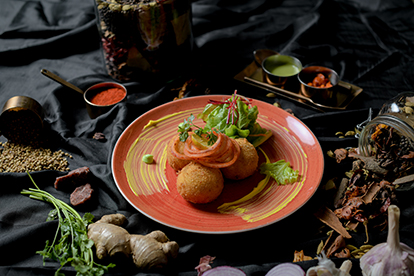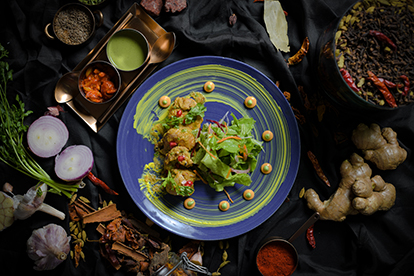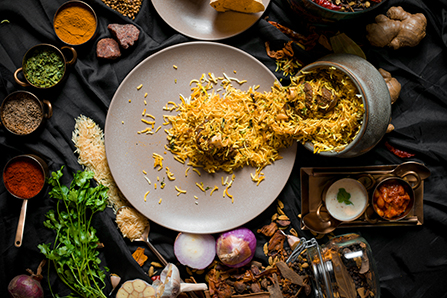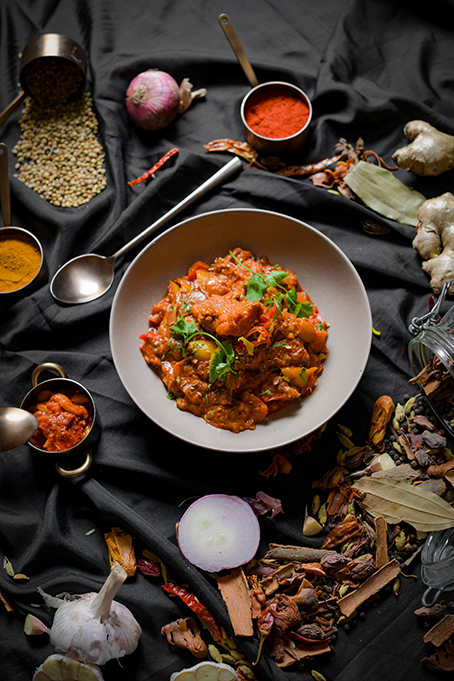Delving into Indian Cuisine: Spice Room- Yak &Yeti
At the cosy corner of Yak &Yeti, Spice Room restaurant serves a sophisticated ambience with different meals at different times. If you are around Durbar Marg, Kathmandu, this is the perfect restaurant to get delicious and authentic Indian Cuisine with you
About the chef:

Mandip Singh, the sous chef of the Spice Room is from Delhi and has been working there for the last two years. As young and positive as he is, his passion for cooking seems vibrant with the way he describes the cooking process. Five years into this field and he has already worked in many hotels in India and now here. The beautiful aspect about him as a chef is that he takes feedback from guests and customizes the dish as per their requests. Grown-up eating Indian food and culture, the authenticity reflects all over the dishes he prepares.
Nepalese taste buds demand an explosion of flavours and spicy foods. The hunt for authentic replication of such amazing dishes is well channelized by the ‘Spice Room- Yak and Yeti’ through Indian cuisine. The restaurant offers an interesting deal where the mornings are for breakfast, lunch is served continental foods, and after 5 PM, the Spice Room comes into action with enriched Indian cuisine for dinner.
A successor to the Sunrise Restaurant, Spice Room is ambient with mixed ideas of Indian and western vibe, complementing their food service. We were warmly welcomed for dinner. As we entered the restaurant, the décor pieces intrigued me. They reflected the Indian home; interestingly, the little boxes, as well as the big jars, were filled with spices. The combination of colourful walls on one side and the other half completely throwing off Zen energy felt right.
Indian cuisine has a big Royal History and must say, royals did have a good choice. In the city of Nawabs, Lucknow, royal chefs eddied the Kabab-styled food as a delightful Starter. As per the preference, the options range from Vegetarian to non-vegetarian. However, for us, the choice was the Dahi- kabab. The simplistic look must not be confused with the heavy weight of the preparation. The ‘Dahi’ meaning Curd, is hung until it’s moisture free and gets thick-creamy (Hung curd). Of course, the Indian touch has to be there with the inclusion of ingredients like spices, green chilli, brown onion, and cardamom powder. The aromatic spiced hug curd now gets outer layered with bread crumbs to go deep frying. The dichotomy of crunch and melting creamy texture comes together in a wholesome manner. No wonder, the Nawabs would be delighted.



On the same plate full of starters, Murgh Tikka “Mirza Hasnu” was there popping off. Straight from the Awadhi cuisine, Rampur, Mirza Hasnu is well received by the guest in the restaurant. Just knowing that this dish would make princes happy, elevates its notion and the creamy base is obviously the highlight. A little tangy, soft, and creamy element along with the subtle taste of chicken gets a chef’s kiss.
The starter continues with the Timuri chicken Tikka alongside green chutney. Now, this is a deal! (Indian and Nepalese flavor amalgam). Timur, mostly used in Nepalese food fusion with Indian Chicken tikka understood the job. I think Timur is something you hate or love, there is no in-between (No worries, I love it). The Mirza Hasnu was more of a softy chicken whereas the chicken tikka was compact yet well done. The green chutney dip surely amplified the palate. All these starters were accompanied by light and fresh salad with the perfect amount of dressing.


For the main course, we were served a few types of Naan, alongside Salmon Kadhai and Dal Makhani. They say Indian guests are much impressed with the Dal Makhani there. The compliment “Delhi wala Dal Makhani” is quite an honour to receive for an Indian restaurant in Nepal. The Dal, Urad Dal (black lentil) to be specific, is soaked overnight over tandoor to be cooked the next day. Altogether 18 hours solely dedicated just to the whole preparation is the ultimate respectful dedication. The next day, the dal is again cooked properly with adding spices, like cream, butter, and seasonings making it a “Buttery Dal”. Honestly, the flavours at once are smooth, a little sweet, and buttery that I could feel the complexity hassling (in a good way) in my mouth. The softness of Naan and the viscosity of the Dal Makhani, with the aromatic flavours, assembled exquisitely. The Salmon Kadhai, on the other, was contesting with a completely different energy. Salmon is normally served with a slight seasoning, contrary to the Spice Room. The spice play did a good job in bringing the Indian taste bud to it. The gravy, the fish chunk, and the spices came off as an Indian Salmon Curry. Going by the look, you hardly would be able to identify it as Salmon but the taste is there, original. The name itself reflects the Indian world and we clean-ate the plate.
Indian cuisine sounds incomplete without Biryani. First cooked in the Royal kitchen of the Mughal empire, Biryani has since then only flourished to fame worldwide. In the sphere of Biryani, the ingredients and spices are not skimped. In the restaurant, we were served their special, ‘Pardanashi Murgh Biryani’, and as interesting as the name is, it does make sense. ‘Parda’ in Hindi means, ‘curtain’, and ‘pardanashin’ means hidden behind the curtain. Since the Birvered with a layer of dough, it gives off the Pardanashi definition. They used lamb for the meat, and Lamb Biryani is the way to go. The chef says this is a dum biryani cooked in a slow process and what makes it stand out is the raw marinated lamb with Basmati rice and essential ingredients. They specifically avoid already cooked meat in the biryani. So, when the meat slowly cooks with everything together, the flavours mellow perfectly. The aroma of rose water and saffron is so beautifully intact that it makes the whole experience satisfying.
After all the food, the ending note had to be something sweet. Here, we are tasting foods from all around India and Kolkatta shouldn’t be missed as well. The very special dessert, ‘Mishti Doi’ has been fused in Nepali style. The dessert is classic sweet curd mixed with saffron, and cardamom powder, and baked to perfection. Originally, the curd has to be mixed with jaggery for the sweetness, but for some reason, Jaggery available was congealing the curd. Therefore, they use sweet curd to make the Mishti Doi and we are not complaining. Since the hung curd is used, the thick creamy texture might feel like cottage cheese. Topped with wild berry compote, it was the perfect way to end the dinner.


